Ruff It Right: The Ultimate Guide to Tent Camping With a Dog
As an Amazon Associate, I earn from qualifying purchases. We may receive a commission for purchases made through these links. This site also contains affiliate links to products besides Amazon and we may also receive a commission for purchases made through those links too (at no additional cost to you).
How to go Tent Camping with a Dog
Did you know that according to The Dyrt’s 2024 camping report, 53.7% of campers brought their doggies to a campsite in 2023? Taking your dog camping is one of the easiest and budget-friendly ways to travel with your pup.
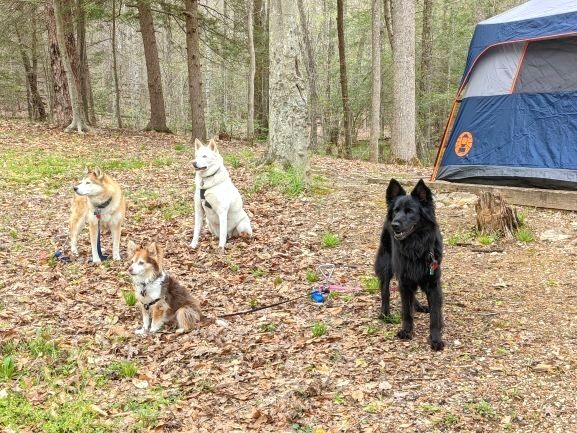
The idea of sleeping in the great outdoors with your four legged friend may seem overwhelming but it’s not as hard as you think.
I’ve put together my best tips to go camping with your dog. We’ll go over what to pack, how to pick the right campsite, important safety tips, and more so you can make fantastic memories with your furry best friend!
We invite you to join our Facebook group for Traveling Pet Owners for a safe space to ask questions and get ideas on making traveling with your pets a positive experience.
How to Take Your Dog Camping For the First Time
Though it’s not as simple as pitching a tent with your pup, taking your dog camping for the first time will be a breeze if you take a little time to prepare. You’ll need to properly plan your camping trip and pack the right camping gear. You’ll also need to know how to keep your pup safe during your overnight camping adventure.
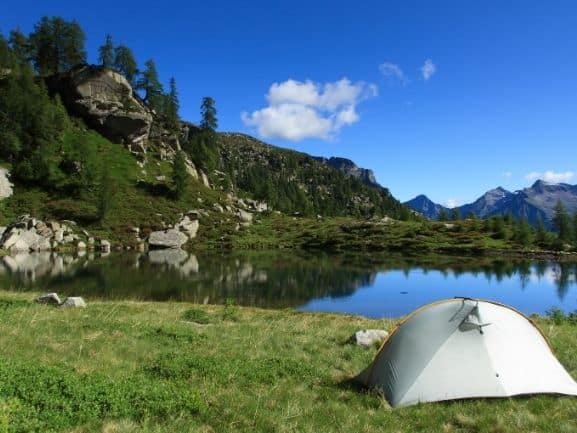
Planning a Camping Trip with Dogs
There are several things you should remember when you start to plan your dog-friendly camping trip. These things will decide your trip’s success like picking the right location and time to go.
- Check that the campground is dog-friendly and read their rules. Some places require proof of vaccinations or have other restrictions like breed or number of pets. This can make camping with multiple dogs more difficult but not impossible!
- Reserve a good camping spot. Try to get a shady spot in a low-traffic area to lessen the chance of your furry friend barking at people walking by. The shade helps keep your canine companion cool and out of the sun.
- Avoid tent or car camping in extreme temperatures to prevent your pet from suffering heat exhaustion or frostbite/hyperthermia. (RV camping gives you the luxury of A/C and heat). In most areas, spring and fall are the best seasons to take your dog camping weather-wise.
- Explore indoor activities that allow dogs if you encounter bad weather.
- Verify that the surrounding trails allow dogs, especially if you are camping in a national park. Many national parks allow dogs in their campgrounds but not on their trails.
- Research the area you will be camping in to learn what wildlife to expect like bears, scorpions, venomous snakes, etc. Don’t forget to learn the toxic plants, fungi, and nuts you need to keep your pup away from.
- Locate the nearest emergency vet just in case you need them.
- Make sure you have your dog camping essentials.
- Do a trial run before your first official camping trip.
Here are more tips on planning a dog friendly vacation.
Dog Camping Gear
When you decide to bring your dogs camping, you will need camping gear and the essentials for you and your pup like collapsible bowls, food, medication, water, etc.
If you’d like camping meal ideas that don’t require numerous ice trips, here are some no-cooler camping meal ideas.
Here are some other items that will make your camping with your dog go more smoothly:
“In Case of Emergency” Information: Have any and all information you would need for emergencies. This would be things like a picture of your pup in case they get lost, dog insurance information, and your home vet’s number. You can have it in a binder, on your phone, or carry a product like our Pet Travel ID or Remington’s Pup Memory Passport.

ID Tags– Double-check that the information on their dog tags is correct. A great tip from the Kas Pack is to add an inexpensive plastic tag to your dog’s collar or harness with your campsite number to make it easier for people to find you if you and your dog get separated.
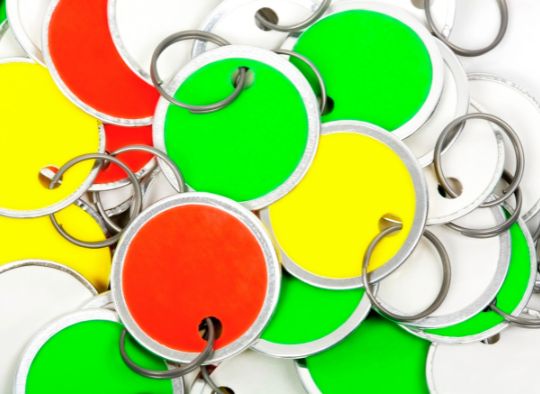
Tie Out– This will make it easier to do certain tasks if you know your dog is safe and secure nearby.
Hands-free leash– If you have a more anxious dog, this will help keep your hands free but allow your dog to be near you. These are great for hikes too.
Comb– If your dog has the type of hair where things get easily tangled, bring a comb with you to get debris out of their fur. Find one that works with your dog’s particular type of hair.
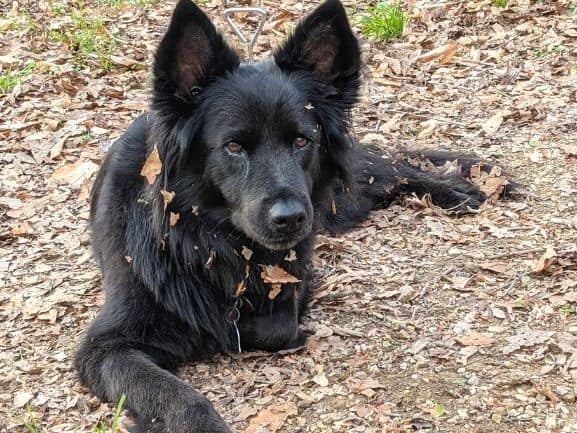
Flashlight/Headlamp– Make sure you have a good flashlight for the after-dark potty breaks your dog will need to go on.
Light-up collar/leash– If your dog is darker in color, you may consider a leash or collar that lights up to make it easier to see them at night.
Dog bed/blanket– Your dog will appreciate having a softer option to lay down on than the tented ground. Especially after all the extra activity, they are probably getting.
Tent Fan– This will help with air circulation and keep the tent cooler.
Jacket/Cool Down Vests and Mat– Have ways to help them deal with either hot or cold temperatures to keep them comfortable.
First Aid Kit– Bring a first aid kit for you and your pup. If you already have a kit, you can easily add some things to make it more dog-friendly to save money. Here’s a post so you can make sure you have everything you and your doggie need in your First Aid Kit.
GPS Tracking– Consider a GPS tracking device like the FitBark GPS tracker for your pup so you can find them in case they run off. Accidents happen and they might not find their way back to you in a new place.
We put together a guide to help you select the right GPS tracker for your needs so you get the right one.

Become a pack member to get the Dog Camping Checklist in our Freebie Library!
Take Your Dog on a Camping Trial Run
Before you book a campsite for a long vacation across the country, do a few camping trial runs first. This will help you and your dog prepare for the upcoming experience and let you know if you need more items to make your trip successful.
If your dog (or you) has never been camping, practice putting up your tent and spending time in it together. You can do this in your living room or your backyard (wherever your tent will fit). This will help your dog get used to being in it which is crucial for your vacation.

You will want to train your dog to be patient and not run out of the tent when you open the door. If you notice this is a problem, you can always put their leash on before you open the tent flap to lessen the chance that they run away.
If you have the time, consider doing an additional practice run at a nearby campsite for 1-3 nights to get the full experience of being around other campers and in an unfamiliar area. Doing this will tell you what additional things you and your dog might need to work on and if you are ready for a bigger outdoor adventure. Trial runs are fantastic because if things don’t go well, you are close to home if you have to shorten the trip.
Arriving With Your Dog to Your Campsite
So you’ve done your planning, booked your site, and are all packed up to go. What do you do when you get there?
Believe it or not, the first thing you do will NOT be setting up your tent. After you have pulled up to your campsite, the first thing to do is take your dog for a walk. This will allow them to use the bathroom and get some energy out while investigating their surroundings.
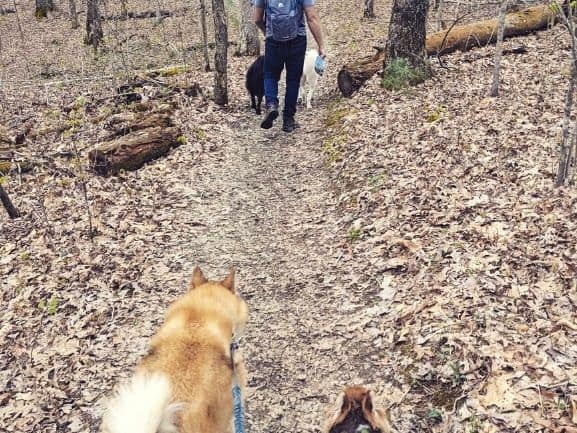
While you walk around your campsite, check the area for things like discarded food, trash, animal waste, etc. You want to remove anything you don’t want your doggy to get into.
Now that you have a calmer pup and a safe space for them to relax in, you will have an easier time assembling your tent. Depending on your furry friend’s personality, you can secure them to a tie-out or a hands-free leash while you set up camp.
Tips for Camping with Dogs
Now that you’ve planned and practiced for your upcoming camping trip with your dog, I have a few more tips to help your trip go smoothly:
Give Your Dogs Plenty of Exercise
Take them on plenty of walks and other outings. Remember the golden rule for canines; a tired dog is a good dog. Barking and other destructive behavior can increase if they have pent-up energy. As long as they get the chance to get their energy out, they will behave better during your trip.
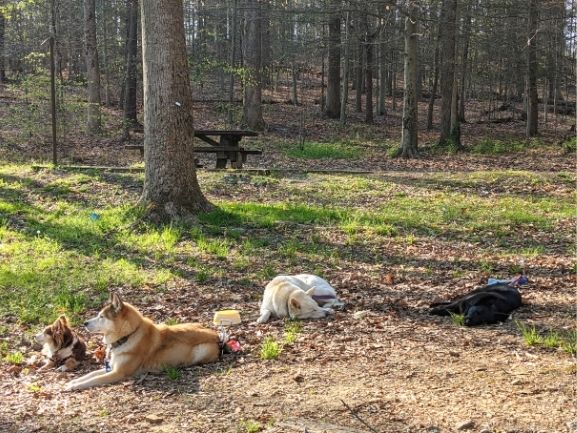
Provide Your Dogs with More Water Than You Think They Need
Keep your pup properly hydrated to avoid any heat-related illnesses. They will likely drink more water than you would expect. Make sure to bring more water than you think you will need on your hikes and always keep their bowl full at the campsite.
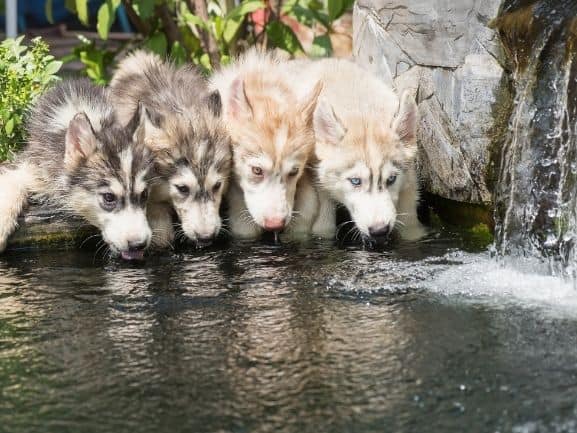
Stick Closely To Your Dog’s Normal Schedule
This is especially important if you have a more anxious dog. Try to feed them around the same time as you would at home so there is some normalcy even when you’re traveling.
Remember that they will still most likely need to go to the bathroom at the same time in the morning and that their bodies are used to going to bed at a certain time. They might even want to go to bed early if you do a lot of hiking.
Safety Tips and Tricks for Feeding Your Dog During Your Camping Trip
Try to clean up any and all food after their meals. You don’t want to attract wild animals to your campsite with spilled dog food or treats. If your dog doesn’t have a huge appetite, you may want to bring something special like treats or wet food to mix into their meal to ensure they are getting enough calories and nutrition during the trip. You may even want to make sure they get extra treats during the day since they will be burning extra calories. Just be careful that you don’t overdo it and cause them to gain unnecessary weight.
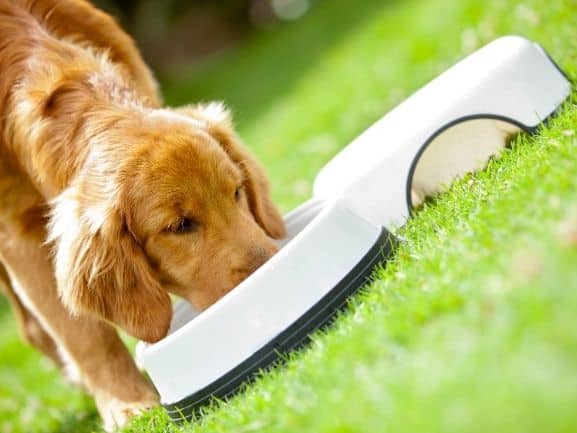
Going on a trip can be a big change for your dog, they may stop eating, eat less, or have loose stool due to stress. Keep an eye on them so you can decide whether you may need to change your plans or take additional steps to keep them safe and healthy.
Tent Safety Tips for You and Your Dog
Bring an extra blanket to keep over your inflatable mattress pad. This will work wonders to keep it from accidentally being popped by your dog’s nails. Many mattresses are sturdy, but this will offer an extra layer of protection to keep them safe.
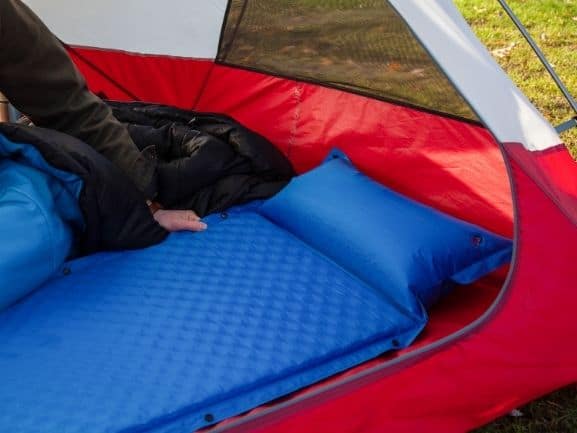
Remember that your tent does not have solid walls. You should never leave your pet alone, especially in your tent. If they become anxious, it is very easy for them to tear through your tent and escape.
Bring a Good Flashlight on Your Camping Trip
This is worth repeating; you will want a good flashlight or a light-up leash for the middle of the night bathroom breaks. This will prevent you from twisting an ankle and allow you to be aware of what is in the area when you walk at night for bathroom breaks.

Get Ready for Campfire Cuddles and Tent Tails
Camping with your dog is a fantastic rewarding bonding experience. It’s also a great budget-friendly way to vacation with your pup! With these tips, you will be perfectly set up to have a safe and memorable trip with your furry best friend.
Things may not go perfectly every trip but that’s okay. Treat every trip as a learning experience so you can fine-tune the process to fit your exact needs. If you realize camping is not for you, you can always look into staying at a private rental or a dog-friendly hotel.
Don’t forget to subscribe to our community to get access to all of the lists and templates in our Freebie Library!
Pin For Later:
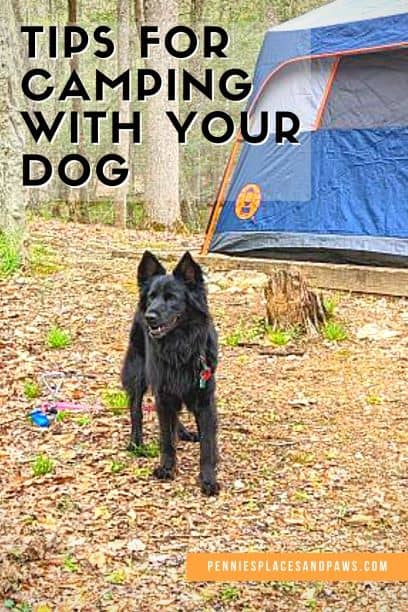
Amazon and the Amazon logo are trademarks of Amazon.com, Inc, or its affiliates.

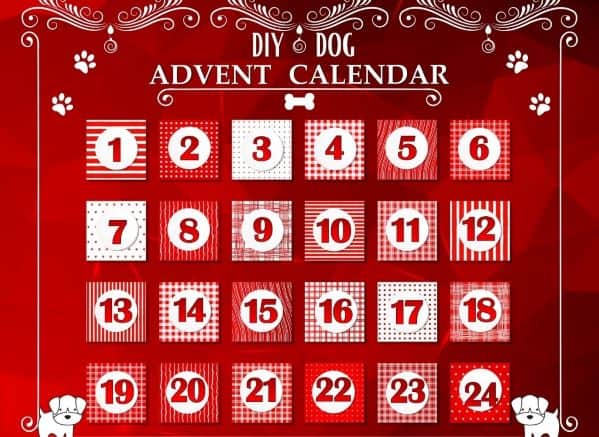
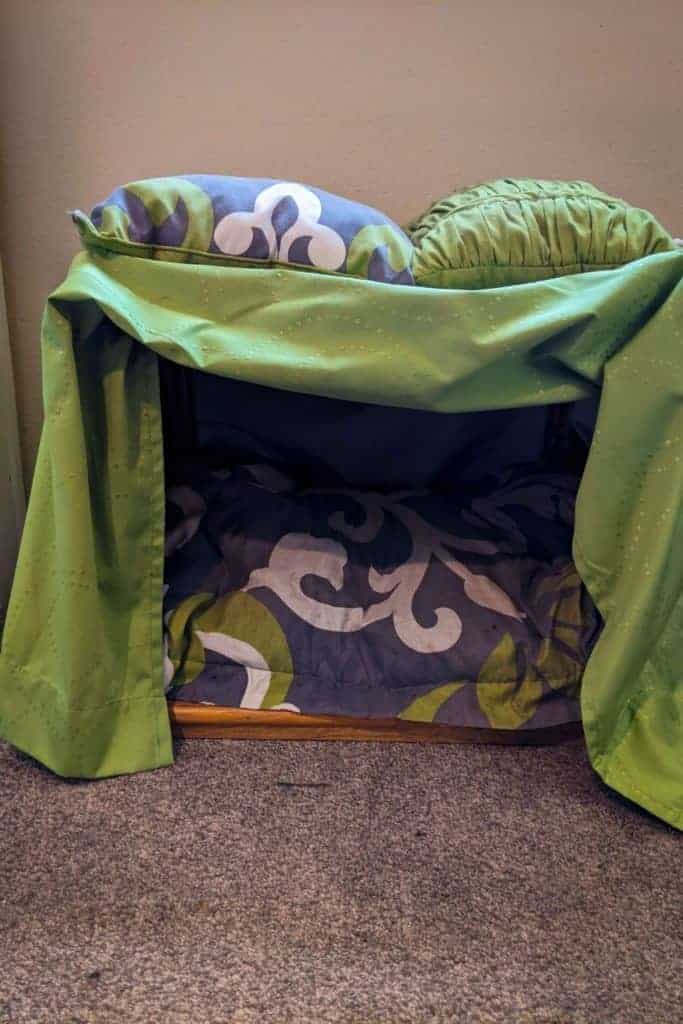
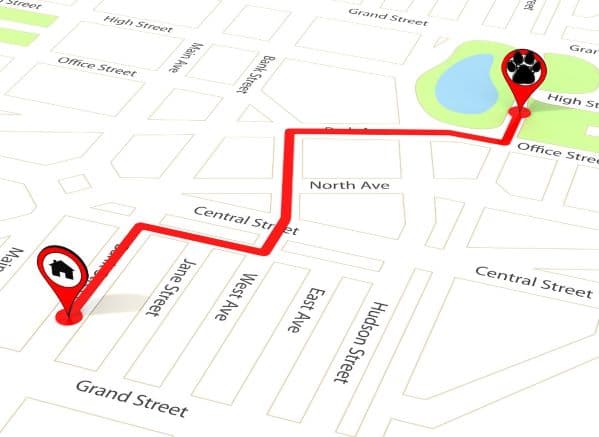

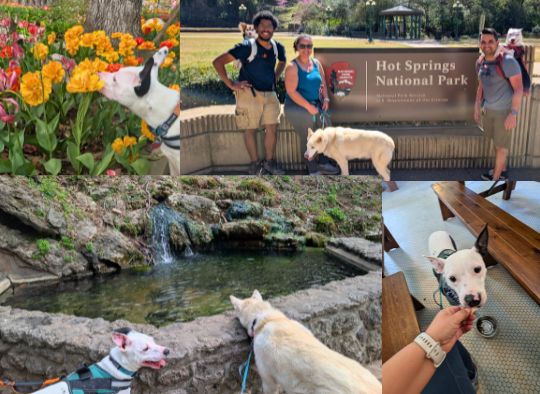
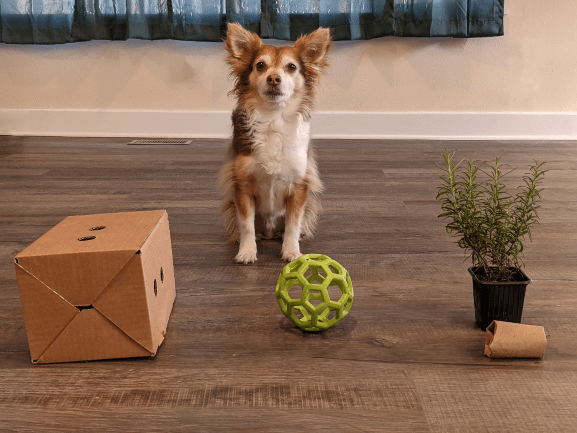
What a comprehensive list and great tips! Safety for yourself and your dogs are paramount especially if you’re exploring the outdoors.
Thank you!
Our dogs adored camping. I had quite a list to go through every time to make sure I didn’t forget anything important.
Now, living in the “wild” we don’t need to travel to enjoy nature.
I love our yard, but we also love traveling so this way the dogs can go with us more often 🙂 Sounds like you live in a great place!
Great tips! I love camping with my dogs, although it’s been awhile since we camped anywhere other than our own backyard.
Thank you! Hopefully 2021 will be kinder and you will be able to explore more 🙂
We have been camping regularly with our dogs their whole lives (over 12 years with Daviana now) and have to agree with the ‘learn from every experience concept. There are still little tips and tricks that we pick up now. That being said, last year alone we were able to take 10 separate tent camping trips, so it can definitely work out! In addition to knowing the hazardous creatures in an area, I highly recommend making sure that every dog you take is fully confident with the ‘leave it’ command. There are times when you look away for 2 seconds and that’s all that it takes for them to grab something they shouldn’t. Being able to get them away from that risk as fast as possible is important.
10? That’s awesome! I bet your pups loved it! And yes, the leave it commands are gold when your dog is out and about in the world.
You have sooo many good tips! We LOVE camping, so it’s always fun when your camping neighbours have dogs with them. Last time we camped, the people in the next site had a kitty as well as two dogs! 😀
We have friends that just got a puppy, so I’ll share this with them.
Thank you! This past week it seemed like everyone had their dogs at the campground. I love seeing everyone’s pups out and about!
These are really important tips, thanks for sharing this comprehensive list! We haven’t gone camping with our dogs yet, but I’d like to. I like that you mention a GPS tracker if your dog will be off leash at all. Tags, Microchip, plus a GPS tracker are a great addition to the safety plan. Preparation is always critical to a successful trip with pets.
Love & Biscuits,
Dogs Luv Us and We Luv Them
We have found several dogs and luckily have been able to reunite them with their owners. I feel much better knowing that if I trip, drop a leash, and a dog runs off…I can find them with GPS!
Fantastic post and tips, I wish I could take Layla on a camping trip, it would be so amazing as I love camping thanks
Thank you! Maybe one day you guys will be able to go camping, even if its in your backyard 🙂
We enjoy 1Bike1World because Dean shows all the splendid stuff you have here ‘in action’. I love the idea of camping with a pet. I know some cats do it too and I love the equipment you showcase.
I had better not show my partner. He will want to rush out and buy a dog THEN go camping LOL!!
I’ll have to check that out! We used to have a cat that probably would have enjoyed camping but I didn’t start until I only had dogs. Good luck with your partner! LOL. My husband has said no more dogs when we had 2, then 3, and then 4. He is the one that finds them and I’ve had to put my foot down on a 5th a few times now!
A hands-free leash is one thing I’ve never tried, but would love to use. I’m afraid if they saw a squirrel, I may go for a ride! (I have 2 bigger sized dogs.) Do you have any tips for how to use it/ train them to use it.
When we use the hands-free leash, we do hold the leash when we know they will be tempted by an animal or treat so we aren’t taken unawares by sudden pulling. So my main tip is to be aware of your surroundings so you can react accordingly. We also train them for regular loose leash walking so they ‘know’ to stay within a few ft range of us when on walks and this carries over nicely to the handsfree leash as long as you don’t give them more leash than what they are used to. We keep ours on a 4 ft long leash. Hope this makes sense. Let me know if I can clarify anything for you!
These are great tips! When I was younger we had 2 dogs that we took camping, it was such fun. One of our current dogs does not like being away from home, but our Maltese is up for anything as long as I’m with her. She especially loves the canoe ride to our camping spot.
Only one of our dogs likes to be on the water so I am super jealous!
These are great tips for camping with your best friend. I will be sharing these with my other dog-loving family and friends. Thanks for sharing.
Thank you for sharing! It can seem very intimidating taking your dog camping the first few times. I know it stressed me out!
I wish I had read this before I took my dogs on a road trip last summer! I made sure to do my research on campsites but did not even think about other attractions along the way and as a result we missed out on a few things. There are also many other great tips in this article that I will be sure to use on our next camping trip!
Our first camping trip, we ended up sitting in the car with the A/C on full blast because our dogs were hot. Now we know to scout out more options to take them inside and outside so that doesn’t happen again. We also bought cooling pads and a tent fan, but when it is storming having another place to go hang out in is great! Glad you found the tips helpful!
Oh wow. I would love to take my dog camping, I think he’d really enjoy it. He loves going everywhere with my husband and I so staying “outside” with him might be a fun experience for him. I’ve always been curious about those glow in the dark leashes. Thanks for sharing these tips.
I got one as a gift from my running partner when they saw me completely wipe out because my black dog got scared and jumped in front of me at night and I didn’t see her. SMH. They are super helpful and have saved me many a skinned knee
Great tips. I might add a reminder for pet owners to use good etiquette when walking their dogs. We were at a state park campground in Illinois and were appalled as we watched a man bring his dog to our campsite to do its business.
Oh no!!! There are impolite people everywhere. Things like that make it harder for the ones with well-behaved pets (and owners) to be out and about. 🙁
I like the thought of practice make perfect. Giving it a try close to home so you will be ready for a longer trip.
The first time we went camping it was only an hour away and it was great practice cause we had thunderstorms and night and high humidity during the day. We knew to bring a tent fan the next outing and that our dogs could deal with the storms (one has high anxiety). We def knew what to tweak when we went 6 hours away the next time!
This is such a great list, I haven’t brought my dog camping yet, but I think she will have such a great time as long as I follow your list.
Thank you! When you do go, let me know how she does 🙂
Great tips. Camping is so much better with our furry friends, but making it work is an art form.
Thanks! It can be very intimidating but well worth it!
Camping with well behaved pets I’m sure is great! Enjoy!
Thanks! We love it 🙂
This post was so helpful! I have a dog who is very much about routine etc and it’s hard to do much traveling with him. I will definitely be referring to this post for this summer! Thank you.
I’m glad you found it helpful! Sticking as close to a normal routine, even when you are traveling can help a lot with anxious dogs 🙂
Great tips for camping. My dogs have always loved camping with me.
Most dogs really do love it!
Oh boy! Sounds like a lot of extras when camping with a dog. But I guess we (the owners) would do whatever it takes to make the enterprise safe and fun
LOL, I think the same thing when I hear about what parents have to do when they bring their children camping! 🙂
What a great list and suggestions for our canine friends!
Thank you!
I’d love to take my dog camping. Beagles are not exactly known for their obedient behavior, though (they pick up a scent and run with it, sometimes completely blocking out all other stimuli).
True, our husky is very pre-driven so I can understand the challenge of not always listening! That’s why I love our hands-free leash and the stake tie-outs. This way they are always secure and safe 🙂
I’ve only gone camping with a dog once (someone else’s), but I’d love to adopt one someday and go on adventures together! Thanks for putting this together–it’ll definitely come into handy!
Thanks! I love it 🙂 Especially on colder nights, it can be like having a little furry heater! LOL
Very thorough post! We don’t camp, and don’t have dogs… so I can’t really relate in that way. But we do have cats. And if we were to travel with them, I know I would want to make sure that they are well protected and taken care of, no matter where we are!
Great tips. Love camping with our pet, it’ such a fun adventure.
I love it! 🙂
Great tips. I used to travel with a dog….but I never tried camping with her. She would have loved it!